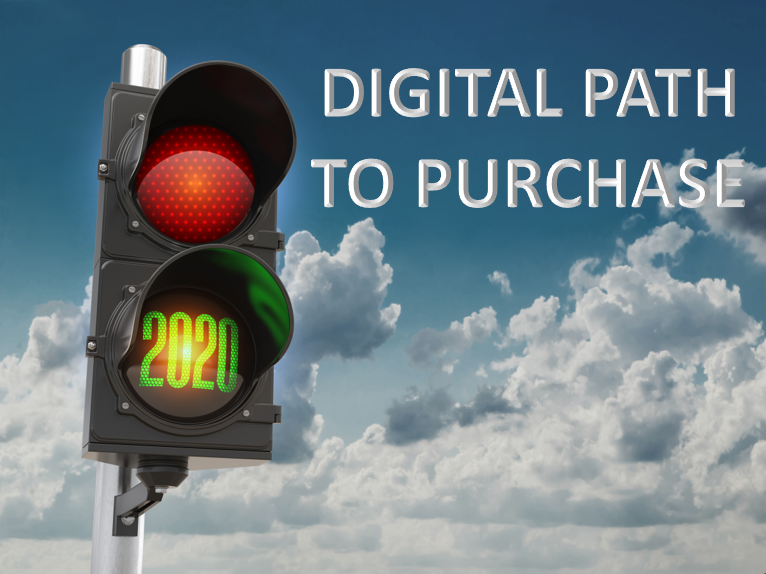Even before the coronavirus pandemic closed physical stores and forced consumers online, they were journeying on the digital path to purchase in increasing numbers. The pandemic only accelerated that trend. “Customers are increasing their appetite for omnichannel commerce as the pandemic continues,” writes journalist Jacqueline Barba (@JackieBarba1). “According to a new global survey of more than 2,500 consumers from Periscope by McKinsey, U.S. respondents want a more digitally focused shopping experience in response to COVID-19. … In the U.S., e-commerce activity was up more than 30% from the beginning of March through mid-April 2020, compared to the same period the previous year.”[1] As a result of increased digital-path-to-purchase activity, online marketplaces have flourished. The staff at DC Velocity reports, “Even as the coronavirus pandemic has accelerated e-commerce growth worldwide, a growing number of companies have turned to online marketplaces — like Amazon, Walmart, eBay, and Rakuten — instead of selling goods over their own websites, saying they are limited by their logistical capabilities, according to a survey released today by French logistics operator Geodis Group and the Accenture consulting firm.”[2]
Data, cognitive technologies, and the digital path to purchase
One of the benefits of consumers taking the digital path to purchase is that they leave data trail markers during their journey. Varun Bhagat (@InstinctVarun), a Senior Technical Consultant at PixelCrayons, notes, “E-commerce has become a game-changer in the past few years. With so much data at hand, it becomes easier for businesses to implement some data analytics in e-commerce, which will have a more significant impact on business decisions. With the increase in digital consumers, organizations take advantage of technologies that can help them to enhance the customer experience and increase the number of customers they retain.”[3] Bhagat lists fourteen ways big data analytics and cognitive technologies can help retailers and brands. They are:
1. Personalizing Services
2. Providing Individualized Experience
3. Predicting Trends
4. Automating conversations with chatbots
5. Researching Social Media Platforms
6. Increasing in Cross-border Sales
7. Improving Forecasting
8. Enhancing Customer Service
9. Refining Targeted Marketing
10. Minimizing Fraud
11. Complying with Privacy Laws
12. Conducting Safe Online Transactions
13. Staying Current Using Real-time Analytics
14. Monitoring Customer feedback
The analytic staff at River Logic observe that online sales for consumer packaged goods (CPG) companies are growing and, in order to succeed, they need to leverage advanced analytics and cognitive technologies just like large, online marketplace providers. They explain, “While online sales are still dominated by large players like Amazon, the online CPG market is changing with numerous new entrants, including niche players. What’s vital for success is that online CPG selling should meet consumer expectations. This requires, in turn, investment in new CPG supply chain technologies able to determine optimal sales, marketing, and distribution strategies.”[4]
Pillars supporting the digital path to purchase
The digital path to purchase is like a bridge from sellers to consumers. Like any bridge, the digital path to purchase needs to be supported by strong pillars. In separate articles, Jim Tompkins (@jimtompkins), Chairman at Tompkins International, and Katie Boschele, Product Manager at Lucidworks, suggest a few such pillars. Tompkins writes, “To succeed in today’s customer-centric world, sellers must offer a seamless journey across every touchpoint. Each sales channel presents a unique opportunity to connect with customers and achieve long-term, profitable growth in a constantly evolving commerce environment. The explosion of digital commerce has created more shopping opportunities than ever before, and today’s consumers are constantly exposed to brands and retailers competing for their attention.”[5] Boschele adds, “The pressure is on for retailers to deliver an unmatched digital experience to gain a competitive edge.”[6] To deliver the kind of customer experience consumers expect on the digital path to purchase, they recommend brands and retailers master the following e-commerce pillars.
1. Site Performance. Boschele writes, “Almost three-quarters (73%) of retailers say site downtime, degraded site performance, and poor customer experience, collectively, is their biggest worry (and the top pain point) during peak demand times. It’s a legitimate fear considering 40% of potential customers bounce if a page takes longer than three seconds to load. AI-powered solutions can increase site performance dramatically by alerting retailers to traffic spikes and product trends so they can react in real-time. It’s also possible for these solutions to proactively troubleshoot, so retailers can identify site performance issues before they corrode sales and support.” Tompkins stresses that the digital path to purchase is involved in all sales channels. He explains, “Even digitally native brands have recognized the need to expand into new channels. Your sales strategy should incorporate mobile, social media, e-commerce, marketplaces, brick-and-mortar and any other places customers shop.” Each of those channels need to provide consumers with a seamless experience.
2. Product Findability. Boschele notes, “If they can’t find it, they can’t buy it. Retailers must prioritize the product discovery experience which drives higher conversion rates, order sizes and loyalty by presenting the right products when customers ask for them. … Retailers should be evolving beyond simple keyword matches when a customer clicks into the search bar. A natural language search engine lets your customers talk to the search bar like they’d talk to an in-store employee. NLU (natural language understanding) takes a request, breaks it into parts of speech, figures out what you’re looking for — and what you aren’t — to return the results right back to the customer.”
3. Geographic Reach. As Bhagat pointed out, e-commerce can increase cross-border sales. Tompkins adds, “Although an ongoing U.S.-China trade war is presenting challenges, it’s important to have a worldwide presence and global shipping and delivery capabilities. If your current infrastructure cannot support international sales, identify ways to broaden your geographic reach as your operation allows, or look for a global third-party logistics provider.”
4. Customer Focus. Tompkins writes, “It’s important to gain customers at every stage of the sales journey. Instagram and Google dominate the ‘discovery’ stage, where customers are researching various products. Amazon wins at the ‘purchase’ stage, where customers know what they want and are ready to buy.” Boschele adds, “In a recent survey, 56% of retailers said they are already using AI and ML to power personalized product recommendations. You can take real-time signals (like clicks, conversions, and add-to-cart actions) from your customers and adjust product offerings and recommendations instantly. This creates a personal online shopping and browsing experience in real time, something that would take your data analysts days to research, adjust, and deliver. Customers are looking for a complete omnichannel experience. One where they can move from online, to mobile app, to in-store and have everything mapped to their personal preference. Retailers should prioritize solutions that allow shoppers to browse online, check prices on the app, and then go in store and buy or be shown similar items to their online experiences in one seamless transaction.”
5. End-to-end supply chain. When consumers think about e-commerce, their considerations generally end with the channel they use to shop. Brands and retailers know the supply chain could be the most important part of e-commerce. Tompkins explains, “Traditional supply-chain models aren’t equipped to meet today’s customer expectations, and digital commerce is driving new strategies as their demands continue to grow and evolve. Rapid, accurate and cost-effective fulfillment and delivery require a strong end-to-end supply chain that can adapt and evolve.”
6. Supporting technology. All of the subject matter experts cited in this article note the importance of technology in every phase of e-commerce. Tompkins notes, “Maximizing product availability requires a level of sophistication that many retail technology solutions have not yet mastered. In addition to providing an amazing customer experience, companies must be able to deliver products as efficiently and cost-effectively as possible. Therefore, it’s important to select a technology stack that can handle the complexities and demands of today’s retail environment — and provide customers with a seamless experience across all channels and stages of their sales journey.”
Concluding thoughts
The importance of the digital path to purchase and e-commerce is only going to grow in the years ahead. Companies that master omnichannel operations will be the organizations that survive and thrive in this new business environment. Omnichannel operations require a seamless blending of online and in-store shopping experiences. Shadowfax analysts explain, “[Retailers need to invest in the] digitization of supply chains to make them omnichannel instead of multichannel, effectively breaking down the organizational silos and bridging the gap between offline and online to meet the new demand patterns of the post-COVID-19 era.”[7]
Footnotes
[1] Jacqueline Barba, “Study: Consumers Hungry for Digital Shopping Experiences,” Path to Purchase IQ, 11 August 2020.
[2] Staff, “Online marketplaces seize growing revenue share during pandemic e-commerce boom,” DC Velocity, 8 October 2020.
[3] Varun Bhagat, “The Impact Of Big Data On The ECommerce Industry,” Host Review, 11 August 2020.
[4] Staff, “Online Consumer Shopping Trends and Supply Chain Technology,” River Logic Blog, 13 February 2020.
[5] Jim Tompkins, “This Five-Pillar ‘Sell Anywhere’ Strategy Will Help Retailers Thrive,” SupplyChainBrain, 12 February 2020.
[6] Katie Boschele, “The 3 Pillars of Digital Experience,” insideBIGDATA, 28 March 2020.
[7] Shadowfax, “Omnichannel — Why it is the future of supply chain post COVID-19,” Medium, 5 May 2020.





